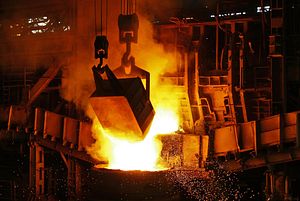Last week, Arrium, one of the two dominant steel manufacturers in Australia went into voluntary administration with debts of over $AU 3 billion ($US 2.3 billion).
With the failing of the company having the potential to affect up to 8,000 jobs nationwide, there have been calls for the federal government to bail out Arrium. The opposition Labor Party wants to instigate a national steel plan to try and prevent future occurrences of this nature.
The most significant impact would be on the state of South Australia, where the company employs 3,000 people. This is further concentrated in the city of Whyalla, where almost one in five people are directly employed in the metal manufacturing industry.
The government of Tony Abbott (replaced in a party coup in last September by current Prime Minister Malcolm Turnbull) refused similar calls to bail out both Qantas and iconic canned foods company SPC (Shepparton Preserving Company). Both companies have since recovered (although SPC did receive funds from the Victoria state government).
The federal government may not be willing to set a precedent, especially with the current instability in commodity prices having the potential to create further troubles for similar companies.
With pressure to bail out Arrium, the current government is facing the existential conflict that all modern conservative parties face in trying to weigh their nationalist instincts against their subscription to free market ideals. While the argument over whether the government should have direct control of the “commanding heights” of the economy was settled long ago, there is still a strong belief that national security, broadly, depends on the success of certain “base” industries.
This became more apparent when the recent Defense White Paper recommended the procurement of a fleet of 12 new submarines. As to the decision of whether they should be built in South Australia or purchased overseas, the White Paper called for the “Australian defense industry to maximize its involvement in the project, without compromising capability, cost, or the project schedule.”
A strictly market-analysis would indicate that better and cheaper submarines can be purchased elsewhere. While the public debate revolves around creating “local jobs” for South Australian industries, this debate sits alongside a wider implication that losing these capacities (submarine building, steel manufacturing), and potential alliances with manufacturers, could be deemed a strategic national weakness.
Australia faces a further dilemma with the current global drop in commodity prices, greatly exposing regions that are almost wholly reliant on natural resources. Towns like Whyalla that rely significantly on one industry–metals–ride the highs and lows of the boom and bust cycles of the global natural resource market.
While the resource boom tied to Chinese growth was deemed to have sheltered Australia from the global financial crisis, the modern phenomenon of the short-term FIFO (Fly In Fly Out) worker that was created further highlights this regional instability.
The transactional nature of this work practice does not contribute to long-term regional economic viability. During boom periods these regions may have money, but they don’t attract settlement. The excellent pay for such work has a tendency to be invested into property and new small business ventures along the populous east coast of the country.
South Australia as a whole suffers greatly from an inability to attract long-term residents, and as a result struggles to create the necessary post-industrial businesses to absorb any downturns in the resource sector. South Australia’s population growth rate is the second slowest of Australia’s six states, growing at under half the rate of Victoria. The South Australian government’s projections see the state, at best, only adding around 500,000 people by 2041. Meanwhile the city of Melbourne, in Victoria, will almost double to around 8 million people in that period.
South Australia has the highest rate of unemployment in the country, with youth unemployment double the overall rate.
Around 20-30,000 of the state’s highly-skilled workforce relocate to other areas of Australia, or overseas, each year. The youth brain-drain to Australia’s big, cosmopolitan, opportunity-laden cities like Melbourne and Sydney is significant, and this increases the number of older workers and retirees as a percentage of the state’s population.
Were the government to bailout Arrium, and also decide to build the new submarines in South Australia, the state could become dependent on the federal government for its subsistence.
Iron ore remains Australia’s largest export; however native steel production is struggling to compete globally. It may be the case that should Arrium survive administration it will need to refocus their operations on “smart specialization.” That would mean moving the company away from the mass-produced steel used in large infrastructure projects (a market dominated by low-wage countries like China and India), and refocusing on specialized varieties of steel like those produced by Sweden for various blades and drill bits.
With a federal election due by November (and potentially as early as July), the government will undoubtedly be making some brute war-room calculations on how to approach the situation with Arrium. Yet finding the sweet-spot between election strategy and long-term viability may be difficult.

































